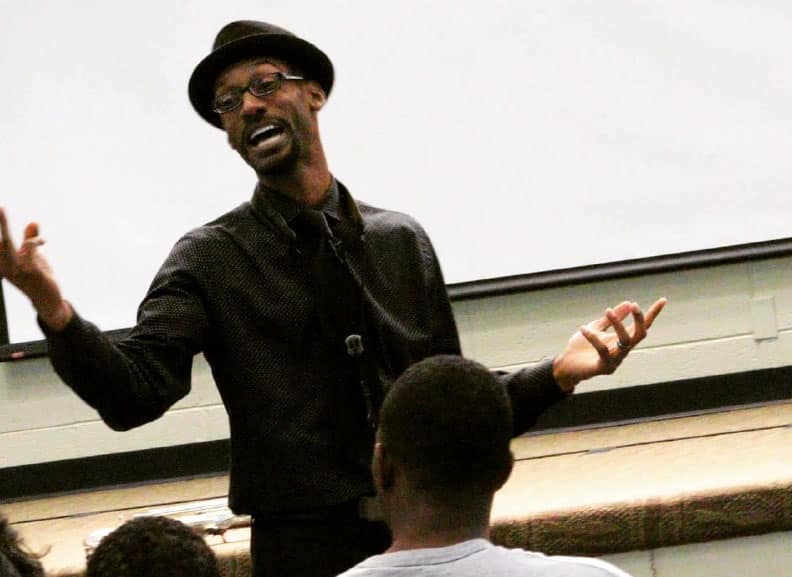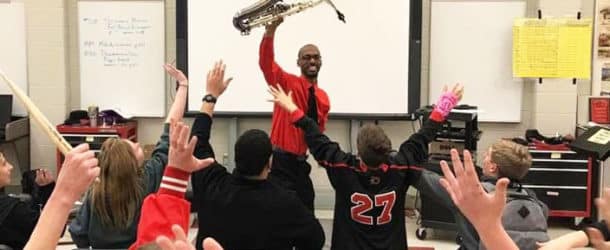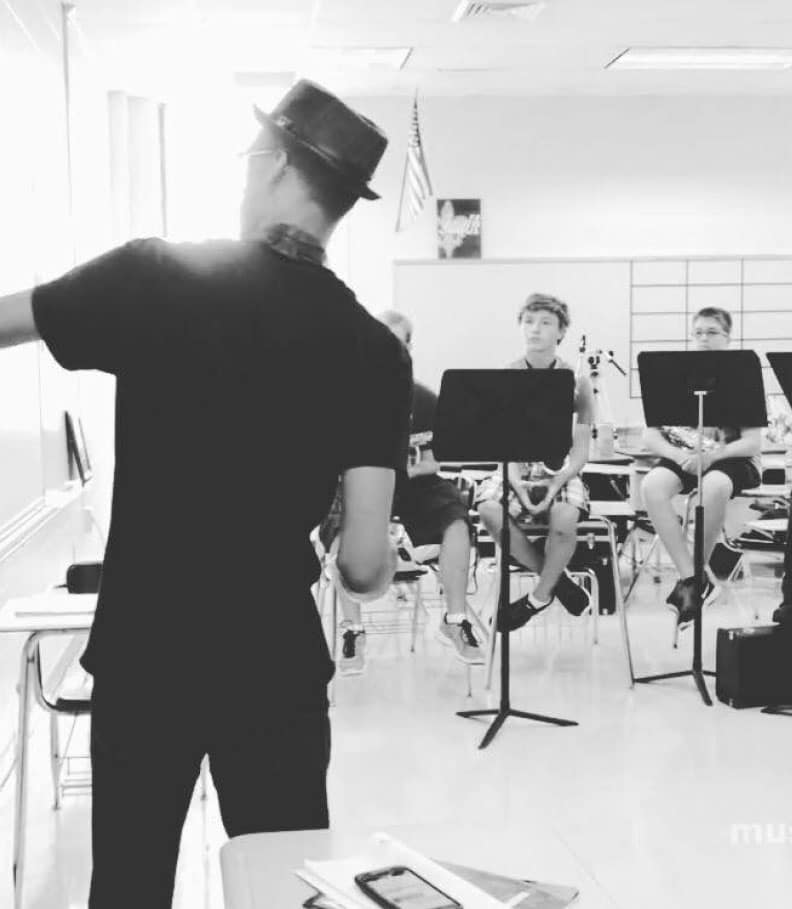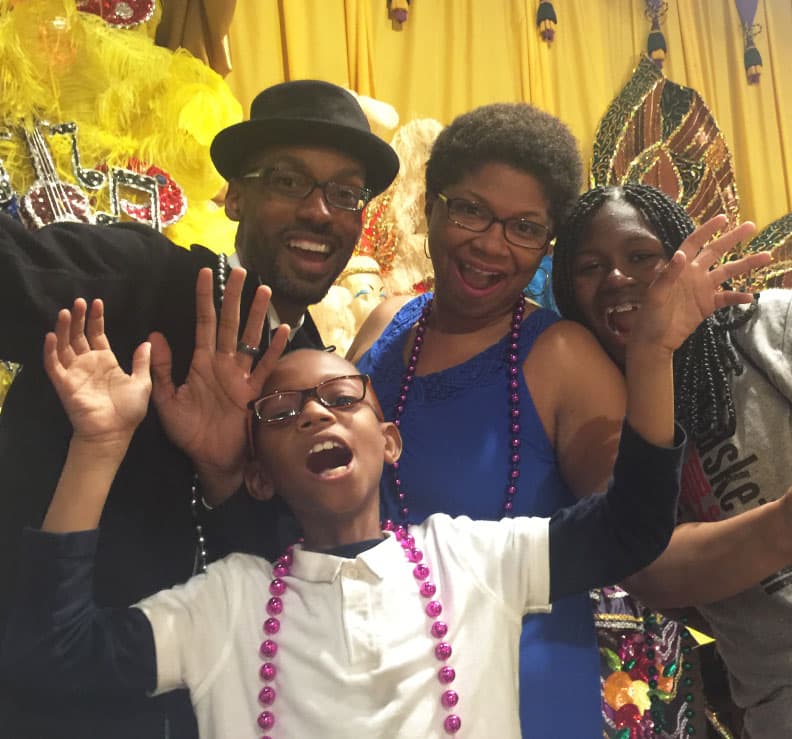Mickey Smith, Jr., Uses His Sax Playing And Teaching To Keep Music Thriving In The Community
By Brad Goins
As a child, Mickey Smith, Jr., didn’t grow up on a steady diet of the jazz masters. Music of many sorts made its way to the family record player.
“I grew up listening to a lot of different genres,” says Smith. He remembers B.B. King and Al Green as two musicians who showed up often in the home music rotation.
It was in public school that Smith first started listening to jazz. When he was in sixth grade, he joined the S.P. Arnett Middle School Band (Sulphur) under the direction of Christ Hungerford and picked up the saxophone.
“It was the school program … That was the beginning of my journey … It was pretty rough. But I continued.”
When he moved on to Westlake High School, Smith’s school band leader was well-known local jazz figure Jay Ecker. “He was able to direct me in a way that brought out the passion,” says Smith.
But it was Smith’s sister Lisa, who lived in Houston, who enabled him to get a clear vision of what it might mean to be a serious professional jazz saxophone player. She introduced him to the recordings of sax man Kirk Whalum. “That’s when the love of it flourished,” says Smith. “I discovered what jazz could be and what I could be.”
Smith says that when he graduated from high school, no one in his family had ever discussed the possibility of a family member going to college. But, says Smith, “music allowed me to go to college.” He was offered a host of music scholarships, but opted for staying close to home at McNeese State University. At the school, he performed in a number of groups and eventually acquired his MFA in music.
He then began teaching. Indeed, at that time, he was much more focused on teaching music than on playing the saxophone.
But something came along that changed all that. Hurricane Rita.

When he moved back to the Lake Area in 2009, he says, he “didn’t have the results” that he’d had in Houston when he’d played his jazz sax. “The market [here] wasn’t ready for it. It was a little frustrating.”
So Smith tried to solve the problem by starting his own local venue. It didn’t have a name and it was only open for performance on Sundays.
At his first show, there was a total of five people in the audience. And some of those had come by chance (that is, without knowing they were going to hear a jazz saxophone player). Three in the crowd were grandmothers. Halfway through the show, they stood up and said, “We’ve got to go pick up our babies.” But they told him they liked the music, and advised him to stick with it.
‘It’s A Beautiful Thing’
About four years later, Smith’s fan base had grown to the point that he was ready to start his Sax in the City event.
“We’re growing each year,” he says. One recent event attracted more than 700 listeners. Smith says Sax in the City isn’t about his highlighting his sax chops. “It’s always been about helping the community.”
One way it does that is by getting instruments in the hands of youths who want to make music. Sax in the City supports and raises funds for the charitable venture MusicMakers2U, of which Smith is the president. MusicMakers2U collects used instruments; refurbishes them; then passes them on to young local musicians who need them. Some of the instruments are fairly beat up when the group gets them. “It costs money to secure these instruments and repair them,” says Smith.
During the intermission of each Sax in the City show, MusicMakers2U gives its latest batch of instruments to the young recipients. A child is called to the stage, but has no idea why. When he gets there, he’s given his own personal music maker.
“It’s a beautiful thing,” says Smith. “The community can put a face on [what happens in the program].” The group just gave its 400th instrument to a young musician.
Smith’s Jazz
It’s not easy to pin Smith down when it comes to the type of jazz he plays. “I hate to categorize my music. I’d call it inspirational jazz.
“The sound should be something that uplifts.
“I love the jazz. I love the fact that it’s expressive; it’s improvisational. It mimics life.”
Smith isn’t one of those players who’ll tell you that his music is 10 or 20 percent improv. The improvisation, he says, “is always there. It always happens.”
He describes one improvisational technique he uses in performances. “I can make my sax sound like it’s talking.” For instance, he may say to the crowd, “even when we’re talking … ”; then, he mimics the exact intonation of the statement with his saxophone. The audience immediately picks up on what he’s doing, and audience and player go into a call and response sequence. (Smith also told me that just like one of his heroes, jazz sax pioneer Roland Kirk, he has played two saxes at once before.)
When Smith has some down time, he listens to music that might surprise some jazz purists. A recording he selects very often is Grover Washington, Jr.’s All My Tomorrows. “It’s very introspective; very intimate; very peaceful and serene.” He notes that Washington was accompanied on the album by Nate King Cole’s brother, Freddy, who, Smith says, sounds almost identical to Nat. The record, says Smith, was “one of the first CDs I bought.” So it provides a sentimental boost.
Smith also “love[s] listening to vocalists,” and especially Al Green.
‘My True Instrument’
Smith is not a sax man first and a teacher second. “I feel like my teaching is my true instrument,” he says.
As a music and band teacher at Maplewood Middle School in Sulphur, Smith practices what he preaches. He’s started the Sound180 music teaching program. The 180 indicates the number of days teachers instruct students each year.
And as for the sound part …
The sound, says Smith, is much more than the words music teachers use as they instruct. It’s also the movements they make; “the techniques used in teaching.”
“Teaching at its highest level is an art form; a performance … Each person has a chance to elevate a sound … All teachers have their individual thumb print … [Each has a] unique quality, like a sax has a unique quality.”
As he puts it on his web site mickeysmithjr.com, “We all possess a unique teaching sound that must be performed with excellence on the classroom stage, to our student audiences … Every child is one sound adult away from discovering their success.”
The teacher as performer must be accessible and communicative. “It’s important to make things relevant to young people,” says Smith.
Smith’s teaching program has drawn the attention of CBS and NBC, which have run feature stories about it.
When Smith was recently nominated for a Grammy, it wasn’t for his saxophone playing. He was nominated for Music Educator of the Year.
He knows how that happened. A local musician who observed one of Smith’s music classes nominated him to the Grammy committee. Smith was one of 7,000 nominated for the award. He survived the elimination process to become one of the 10 finalists who was eligible to get the Grammy. And though he didn’t win it, he was first runner-up.
The whole process was a humbling one for Smith. “It puts you in a reflective mood,” he says. It also enabled him to expand his knowledge of music education in general. It “allowed [him] to connect with incredible educators around our country.”
‘Music Is What I Can Provide’
Smith grew up in the nearby town of Mossville — a place he says is not there anymore. “It is a very integral part of my development. My first sounds were part of that community.”
Whatever Smith talks about, his comments always end up being about the importance of community. A big part of his community is his wife Eugenia. A teacher in her own right — she teaches literacy at S.P. Arnett — she also handles certain managerial aspects of Smith’s career. She and her husband sit around and enjoy conversations in which they try to pinpoint just what kind of music it is that Smith plays.
The couple has two children, William and Mikayla. Mikayla, now in the eighth grade, plays the French horn in the band her father conducts.
At present, he has 168 students.
Although Smith is only 38, his words indicate that he is already aware that he only has a limited number of years ahead of him. And what he wants to do with them is ensure that the knowledge of and passion for music is passed on in his community after he is gone.
“Music is what I can provide in this life … I want to know that somebody’s going to keep the music going.”



















Comments are closed.